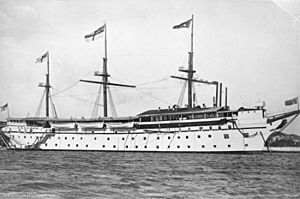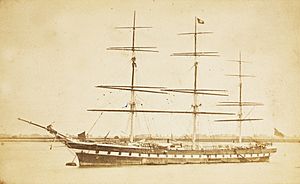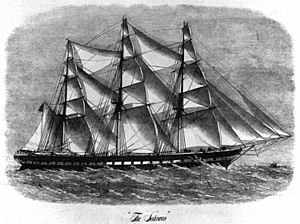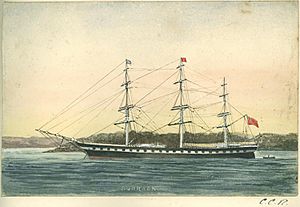HMAS Tingira facts for kids
class="infobox " style="float: right; clear: right; width: 315px; border-spacing: 2px; text-align: left; font-size: 90%;"
| colspan="2" style="text-align: center; font-size: 90%; line-height: 1.5em;" | 
|} HMAS Tingira was a special training ship for the Royal Australian Navy (RAN). It was used between 1911 and 1927. A company called Alexander Hall & Co. built the ship in Scotland in 1866. It was a large passenger ship called Sobraon. It was the biggest sailing ship ever made with a special 'composite' hull.
The Sobraon sailed between England and Australia every year until 1891. Then, it was sold to the government of New South Wales. They used it to help train young boys. In 1911, the Australian government bought it, and it joined the RAN. Tingira stopped being used in 1927. Even though people tried to save it, the ship was taken apart in 1941.
Contents
- Building a Mighty Sailing Ship
- Sobraon: A Journey Across the Seas
- HMAS Tingira: Training Future Sailors
- The End of a Long Journey
Building a Mighty Sailing Ship
Clipper ship Sobraon, Gravesend, England, around 1875
The Sobraon was first planned to have both sails and a steam engine. However, the idea for the steam engine was dropped while the ship was being built. With all its sails up, Sobraon had a huge sail area, like two football fields! It could sail as fast as 16 knots (about 30 km/h).
The ship's cargo area was 27 feet (8.2 meters) deep. It even had space for farm animals. The hull, which is the main body of the ship, was built in a special way. It had strong teak wood planks over an iron frame. This made Sobraon the largest sailing ship ever built with this 'composite' style.
Alexander Hall & Sons built Sobraon in Aberdeen, Scotland. It was given the building number 239. The ship was named after the Battle of Sobraon. It was launched, meaning put into the water for the first time, on 17 April 1866.
Sobraon: A Journey Across the Seas
The ship was built for Shaw, Lowther, Maxton & Co. But it was first operated by a company called Devitt and Moore. They bought the ship in 1870. The Sobraon was used to carry people migrating from England to Australia. It made one trip from England each year.
Its first voyage left London on 9 November 1866. It arrived in Australia on 4 February 1867. At first, the trips ended in Sydney. But from 1872 onwards, Sobraon started sailing to Melbourne instead.
The ship was very fast and had great facilities. It had a machine to make fresh water and a large ice chamber. It even provided fresh milk every day from animals kept on board! This made Sobraon one of the most popular ships for people moving to Australia.
For its first three return trips, Sobraon carried Indian tea. It would race other ships back to England to deliver the first cargo. After these trips, the ship started carrying Australian wheat and wool on its way back to England.
Sobraonas a passenger ship
On 14 October 1890, Sobraon began its last journey to Australia. It reached Melbourne on 4 January 1891. Later that month, it was sold to the government of New South Wales. Then, it was moved to Sydney.
The government used Sobraon to help train young boys. These boys learned skills for a career at sea. The ship was anchored near Cockatoo Island. It was called the "Nautical School Ship Sobraon". Over 4,000 boys were trained on the ship during a 20-year period.
HMAS Tingira: Training Future Sailors
Watercolor of Sobraonby Charles Collinson Rawson
The Australian federal government bought the ship in 1911. They wanted to use it as a training ship for the new Royal Australian Navy (RAN). The ship was refitted, meaning it was updated and changed for its new role.
It was officially added to the RAN as HMAS Tingira on 25 April 1912. Tingira is an Aboriginal word meaning "open sea." The ship was anchored in Rose Bay. Up to 250 boys, aged between 14 and 16, could be trained on the ship at one time. However, there were usually fewer than 200 trainees.
Between 1912 and 1927, 3,158 boys were trained for naval service on Tingira. Since Tingira stayed in one place, a smaller steam yacht called HMAS Sleuth was used with it. This smaller ship helped give the new recruits experience sailing on the open sea.
The End of a Long Journey
Tingira stopped being used on 30 June 1927. It was then stored in Berry's Bay. In 1929, the ship was sold to a private owner. But he passed away in 1935 without using it for anything.
In 1936, Major Friere, a retired British Army officer, bought Tingira. He was working with Louisa Ankin to save the ship as an important national piece of history. Two years later, the ship was sold to a company that takes apart old ships. Friere and Ankin tried to buy the ship back, but they were not successful. Tingira was taken apart in 1941.
Even after Tingira was gone, its legacy lived on. Teenage trainees at the RAN's Junior Recruit Training Establishment wore special patches with the name "Tingira." This was a way to remember the important training ship. There is also a small park called Tingira Memorial Park in Rose Bay. It was created to honor HMAS Tingira. The park was built in two stages, opening in 1962 and finishing in 1977.
| History | |
|---|---|
| Name | Sobraon |
| Namesake | Battle of Sobraon |
| Owner | Shaw, Lowther, Maxton & Co. (1866-1870) |
| Operator | |
| Route |
|
| Builder | Alexander Hall & Co. |
| Yard number | 239 |
| Launched | 17 April 1866 |
| Maiden voyage | 9 November 1866 to 4 February 1867 |
| Out of service | January 1891 |
| Identification | Official Number 54680 |
| Fate | Sold to Government of New South Wales in 1891, sold to Australian federal government in 1911 |
| Name | Tingira |
| Acquired | 1911 |
| Commissioned | 25 April 1912 |
| Decommissioned | 30 June 1927 |
| Fate | Broken up in 1941 |
| General characteristics | |
| Tonnage | 2,131 GRT |
| Length |
|
| Beam | 40 ft (12 m) |
| Draught | 16 ft (4.9 m) mean |
| Depth of hold | 27 feet (8.2 m) |
| Sail plan | 2 acres (0.81 ha) sail area |
| Speed | Up to 16 knots (30 km/h; 18 mph) |
| Capacity |
|
| Crew | 69 (as Sobraon) |




